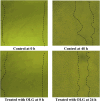Watercress oil loaded with gel: evaluation of hemolysis inhibition, antioxidant, antimicrobial, and healing properties
- PMID: 39246652
- PMCID: PMC11377900
- DOI: 10.3389/fphar.2024.1424369
Watercress oil loaded with gel: evaluation of hemolysis inhibition, antioxidant, antimicrobial, and healing properties
Abstract
Plant-derived compounds are renowned for their remarkable pharmacological properties, holding immense promise for therapeutic interventions in human health. In this study, we aimed to assess the antimicrobial, anti-hemolytic, antioxidant, and wound healing attributes of watercress oil incorporated into Vaseline gel (OLG) compared to watercress oil alone. OLG was formulated through a meticulous process involving the addition of Vaseline gel to the oil under agitation conditions. High-performance liquid chromatography analysis of watercress oil unveiled a rich array of phenolic compounds, including gallic acid (10.18 μg/mL), daidzein (3.46 μg/mL), and hesperetin (3.28 μg/mL). The inhibitory zones caused by watercress oil alone against a spectrum of pathogens, including Staphylococcus aureus, Escherichia coli, Klebsiella pneumoniae, Enterococcus faecalis, and Candida albicans, were measured at 25 ± 0.3, 26 ± 0.1, 22 ± 0.2, 25 ± 0.2, and 24 ± 0.1 mm, respectively. Notably, OLG exhibited slightly larger zones of inhibition (27 ± 0.2, 30 ± 0.2, 24 ± 0.1, 28 ± 0.1, and 25 ± 0.3 mm) against the same microbial strains. Furthermore, the minimum inhibitory concentration (MIC) of OLG against E. coli and E. faecalis was lower compared to watercress oil alone, indicating enhanced efficacy. Similarly, the minimum bactericidal concentration (MBC) of OLG was notably lower across all tested bacteria compared to watercress oil alone. Inhibition of bacterial hemolysis, particularly K. pneumoniae, was significantly enhanced with OLG treatment, showcasing reductions of 19.4%, 11.6%, and 6.8% at 25%, 50%, and 75% MIC concentrations, respectively, compared to watercress oil alone. The antioxidant activity of both oil and OLG was quantified with IC50 values of 2.56 and 3.02 μg/mL, respectively. Moreover, OLG demonstrated remarkable efficacy in wound healing assays, with notable enhancements in migration rate, wound closure, and area difference compared to control cells. In light of the observed antibacterial, antifungal, anti-hemolytic, and wound healing properties of OLG, this formulation holds therapeutic potential in treating microbial infections and promoting wound healing.
Keywords: anti-hemolysis; antimicrobial; antioxidant; vaseline gel; watercress oil.
Copyright © 2024 Alharbi, Qanash, Almashjary, Barnawi, Aldarhami, Alsaif, Alsamaan, Monjed, Al Shmrany and Bazaid.
Conflict of interest statement
The authors declare that the research was conducted in the absence of any commercial or financial relationships that could be construed as a potential conflict of interest.
Figures






References
-
- Abboud M., El Rammouz R., Jammal B., Sleiman M. (2015). Vito and in vivo antimicrobial activity of two essential oils thymus vulgaris and lavendula angustifolia against bovine Staphylococcus and Streptococcus mastitis pathogen. Middle East J. Agric. 4, 975–983.
-
- Abdelghany T. M. (2013). Stachybotrys chartarum: a novel biological agent for the extracellular synthesis of silver nanoparticles and their antimicrobial activity. Indonesian J. Biotechnol. 18. 10.22146/ijbiotech.7871 - DOI
-
- Abdelghany T. M., Bakri M. M., Ganash M., Amin B. H., Qanash H. (2021). Effect of Thevetia peruviana seeds extract for microbial pathogens and cancer control. Int. J. Pharmacol. 17, 643–655. 10.3923/ijp.2021.643.655 - DOI
-
- Abdel Ghany T. M., Ganash M., Alawlaqi M. M., Al-Rajhi A. M. H. (2019). Antioxidant, antitumor, antimicrobial activities evaluation of musa paradisiaca L. Pseudostem exudate cultivated in Saudi Arabia. BioNanoScience 9, 172–178. 10.1007/s12668-018-0580-x - DOI
-
- Abdul Kareem M. W., Al Dhaher Z. A. (2021). Evaluation of the antifungal activity of Nasturtium officinale (watercress) oil with calcium hydroxide against Candida albicans isolated from root canal. J. Baghdad Coll. Dent. 33, 1–5. 10.26477/jbcd.v33i4.3012 - DOI
LinkOut - more resources
Full Text Sources
Molecular Biology Databases

